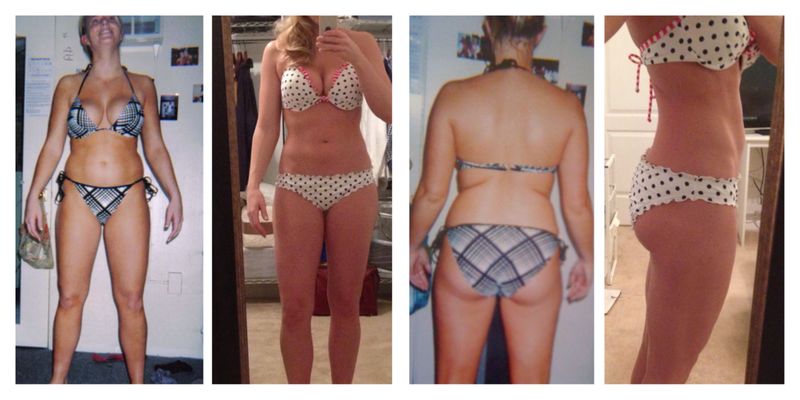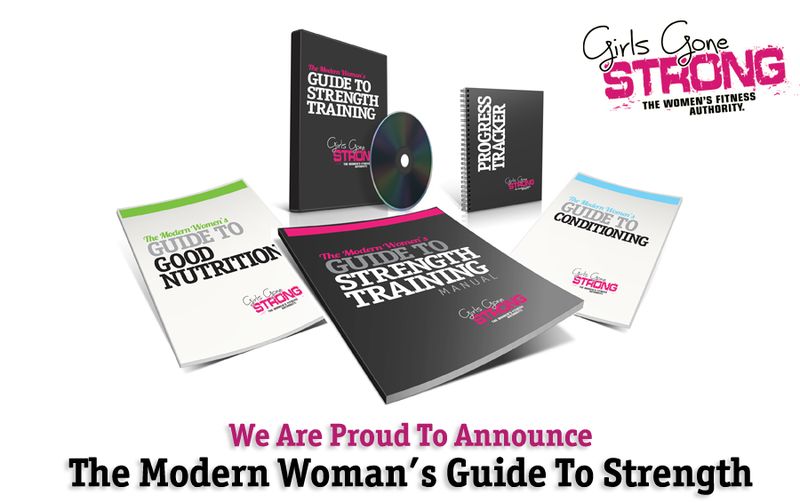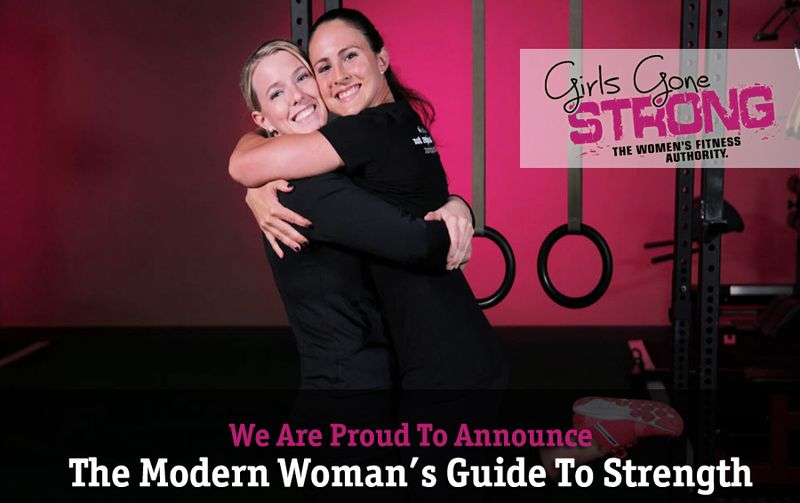If you’re anything like me, you’re always trying to figure out how you can get exactly what you want for the least amount of time/money/effort/etc.
You want maximum value.
You want the best deal.
You want the highest return on your investment.
And I don’t blame you. I feel exactly the same way, especially about my training program. I spent years slaving away doing hours of cardio, crazy 2-a-day training sessions, absolutely killing myself in search of the body and health I wanted.
What did I get?
Back pain.
Hashimoto’s (autoimmune hypothyroidism).
PCOS (polycystic ovarian syndrome).
Adrenal issues and exhaustion.
You know what I’ve finally learned? How to get the absolute maximum results in the gym with the least amount of effort. Want proof? See below.
 The polka dot bikini is a photo of me from 4-5 weeks ago. For the last several months I’ve trained less than 4 hours a week.
The polka dot bikini is a photo of me from 4-5 weeks ago. For the last several months I’ve trained less than 4 hours a week.
I am including the photo on the left (that’s from 10 years ago) so you can see that I haven’t always been bless
ed with a lean and fit body. And to give even more evidence that lifting really heavy things does NOT make women huge, but rather, coupled with a good nutrition program it makes them lean and curvy and athletic looking.
So what have I learned? Let me share. Here are the 4 principles you MUST follow to get the most results with the least amount of time and effort:
1.) You must master the basics.
I’m sure you hear Josh preach this all of the time. How can you ever expect to build something amazing, if the foundation is non-existent? I liken it to a young child starting school. What do they learn in Kindergarten? Letters, numbers, words, addition, subtraction, and so on. The basics, right? How ridiculous would it be to try to teach a 6 year old Calculus on their first day of Kindergarten? That’s what happens when take someone who is new to strength training and throw them into an advanced program on Day 1.
So what does it mean to master the basics? First and foremost, you need to know how to breathe properly. Doesn’t get any more basic than that, right? Alas, that’s an entire post in itself, so we will save that for another day.
You need to master basic human movement patterns like: squat, hinge, push, pull, single-leg and split stance movements, and resisting movement with your core. Start with body weight versions of these movements and over time you can progress to adding load or trying more challenging variations.
2.) Choose big, bang-for-your-buck exercises.
Like I mentioned above, the basic human movement patterns are squat, hinge, push, pull, single-leg and split stance movements, and resisting movement with your core. Nary a “triceps kickback, or a biceps curl, or a leg extension” to be found. Not that those are “not things that our body does.” Of course our body does them. But they aren’t what’s going to get you the most results in the least time.
Here’s an experiment. Do 20 biceps curls with 10% of your body weight in each hand (20% total). Rest 1 minute. Then do 20 squats holding 10% of your body weight. Note how you feel. How much more taxing were the squats? A ton, right?
Now if you absolutely loooooove doing isolation work, throwing in a couple of sets at the end of your workout is one thing, but make sure that 90% of your effort goes toward squats, deadlifts, rows, pressing movements, planks, carries, and lunges.
You’ll gain more strength, gain more muscle, and lose more body fat in less time with these exercises. Who doesn’t want that?
Bonus: they are SO much more fun and entertaining. Trust me.
3.) Lift heavy.
Remember that little analogy about the Kindergartener and what they learn in school? What do you think would happen if for the next 5 – 10 years they continue to work on numbers, letters, words, addition, and subtraction? They would stop improving and getting smarter, right? Same thing with strength training.
Yes, you must master the basics in the beginning, but at the beginning, even just your body weight will be considered “heavy” for you, because you haven’t adapted to the movements and the load yet. So keep in mind that “heavy” is all relative.
For a beginner, deadlifting a 35 lb. kettlebell might be heavy, while for an intermediate or advanced lifter, heavy may be a 225 lb. barbell.
The reason that heavy lifting is so important is to make continual progress. You must continue applying greater stress to your system to ensure that your systems adapts and improves.
In other words, you apply a stress your muscles and/or your central nervous system, and then your body tears down muscle tissue and rebuilds it bigger and stronger than before, or it increases the efficiency of your neural pathways so you can recruit more muscle fibers more effectively in the future.
Simply put, your body figures out how to make the task you just performed easier in case you have to perform it again in the future. If you’re not lifting heavy enough or challenging yourself, you’ll stop making progress.
4.) Recover harder than you train.
I wish I could plaster this all over every woman in America’s bathroom mirror. In order to make continual progress over a long period of time while feeling good, you must recover harder than you train.
Remember, when you are in the gym, you are actually causing very minor damage to your muscles and applying stress to your system. You must then give your body the rest and nutrients that it needs to recover from that stress. Otherwise, the next time you go in the gym, you won’t have recovered from the damage and you’ll be causing more damage. And more damage. And more damage. (See where I’m going with this?)
It’s like constantly taking money out of your bank account and never putting any back in. You end up physically bankrupt, and we all know how much harder it is to recover from bankruptcy once you’re in that hole. You want to always keep a “buffer” in your account to ensure you never get in the red.
The best ways to put money in your account are as follows:
- Don’t do a dumb program in the first place.
- Learn how to breathe properly.
- Make sure you’re eating whole, nutrient-dense foods 90% of the time.
- Getting plenty of rest (7-9 hours) in a cold, dark room.
- Manage your stress effectively.
- Engage in recovery activities like: massage, Epsom salt baths, low to moderate intensity cardio, foam rolling, etc.
- Get moderate amounts of sunshine regularly.
- Surround yourself with positive and uplifting people.
Doing these things on a regular basis will ensure than you always have “enough in the tank” to recover from your training and continue to make progress while staying healthy.
If you want more information on how exactly how to structure a proper program that will help you get stronger, leaner, healthier, and feel absolutely amazing with minimal time and effort, you MUST check out The Modern Woman’s Guide To Strength Training.
This is the culmination of an incredible team pouring their heart and soul into creating this training and nutrition resource for women for 9 months.
So what’s included in the Modern Woman’s Guide To Strength Training? We are so glad you asked!
You get:
- The Modern Woman’s Guide To Strength Training Getting Started Guide – this program comes with a LOT of information, but the getting started guide will walk you through it step-by-step.
- The Modern Woman’s Guide To Strength Training Manual – what is strength training, why is it important, a glossary of terms, and information about recovery, sleep, and stress management.
- The Modern Woman’s Guide To Strength Training Programs – three 16 weeks training programs for beginners, intermediates, high-level intermediates (with multiple options for every single exercise in case you want to make a substitution).
- The Modern Woman’s Guide To Strength Training Video Library – 90 minutes of high-definition video with me coaching GGS co-founder Alli McKee through 70 exercises. I will discuss proper – form, as well as common mistakes and how to correct them.
- The Modern Woman’s Guide To Strength Training Exercise Glossary – a print version of the video library for quick reference if you forget how a particular exercise is performed.
- The Modern Woman’s Guide To Strength Training Progress Tracker – a progress tracking guide where you can track measurements, weight (if desired), mood, sleep, stress level, strength level, energy level, etc. so you can get a comprehensive picture of what’s going on with your body.
We also offer The Modern Woman’s Guide To Good Nutrition Package as well written by Dr. Cassandra Forsythe, PhD, RD, CSCS, gym owner, and co-author of The New Rules Of Lifting For Women, and The Women’s Health Perfect Body Diet.
Included in this package is:
- The Modern Woman’s Guide To Good Nutrition Manual – 18 chapter manual with everything you need to know from determining calorie level and macronutrient ratio to recommended food sources and beverages, to what medications may be preventing fat loss.
- The Modern Woman’s Guide To Good Nutrition Meal Plan – Cassandra recognizes that every woman is different and needs a different nutrition structure to be successful. She put together done-for-you meal plans for fat loss and maintenance at multiple calorie levels, as well as a FODMAP plan for women with digestive issues, a Paleo meal plan at multiple calorie levels, and outlined multiple If It Fits Your Macros (IIFYM) plans for those who prefer that type of plan.
Oh, and we have secret bonuses we will be announcing this week, as well. So stay tuned. We know you’ll love it!
Click Here: The Modern Women’s Guide to Strength Training
Author Bio:
Molly Galbraith is co-founder of Girls Gone Strong, a movement dedicated to helping women improve their physical strength, mental strength, and strength of character through strength training.
She is also co-founder J&M Strength and Conditioning, a private studio gym in Lexington, Kentucky.
Her mission is to, ”Help women discover and accept what their best body looks and feels like, with minimal time and effort, and once they discover that, help them have grace and compassion about it.”
No stranger to the gym herself, she has competed in figure and dabbled in powerlifting and her best lifts include a 275-lb. squat, a 165-lb. bench press, and a 341-lb. deadlift.


I’m on board with all of the above, but why is it sooo hard to remember to recover as hard as you train?
I do Crossfit and love every single minute of it. You know those people that have to be forced to get to the gym? I’m the opposite, I need to force myself to take a rest day! It is so difficult to realize that it makes much more sense to let your body recover and that you are putting so much stress on ti all of the time that you have to rest to get stronger..
One day I’ll learn!